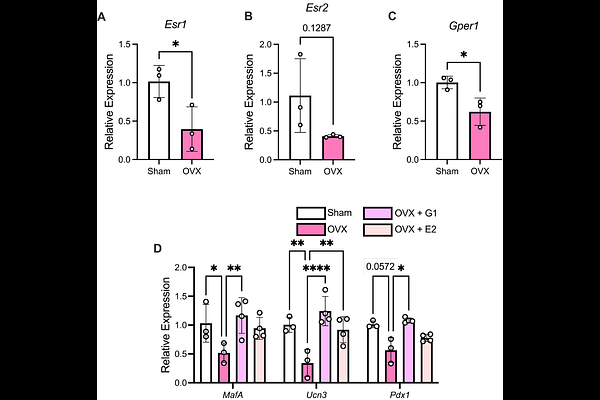G Protein Coupled Estrogen Receptor Signaling Maintains β Cell Identity in Female Mice

G Protein Coupled Estrogen Receptor Signaling Maintains β Cell Identity in Female Mice
McLaughlin, M. R.; Krishnan, P.; Wu, W.; Rostron, C.; Orr, K.; Udari, L.; Del Carmen Aquino, J.; Fisher, A.; Kono, T. M.; Kua, K. L.; Evans-Molina, C.
AbstractType 2 diabetes (T2D) arises in the context of obesity and overnutrition; however, additional demographic features including age and biological sex contribute to T2D risk. Estradiol (E2) is thought to play a protective metabolic role that may govern sex differences in the development of T2D. The mechanisms by which E2 exerts these effects and the impact of reduced E2 signaling in {beta} cells during menopause remain incompletely understood. We analyzed publicly available whole islet transcriptome datasets from female and male cadaveric donors and showed significant age-related modulation of gene expression, including changes in pathways related to {beta} cell function, in islets from female donors. Importantly, these patterns were not observed in islets from male donors. To test the in vivo relationship between E2 signaling and {beta} cell function, 10-week-old female C57BL6/J mice underwent an ovariectomy (OVX) or sham (CTR) surgery, followed by 4 weeks of high-fat diet (HFD) treatment. HFD-OVX mice exhibited obesity-induced glucose intolerance, increased cell mass, and reduced expression of {beta} cell identity markers. Furthermore, ex vivo treatment of islets with the G protein coupled estrogen receptor (GPER)-specific agonist G-1 restored {beta} cell identity gene expression. Together, these data identify a novel connection between GPER signaling and {beta} cell identity and suggest that menopausal loss of E2 signaling through GPER may be linked with loss of {beta} cell identity.